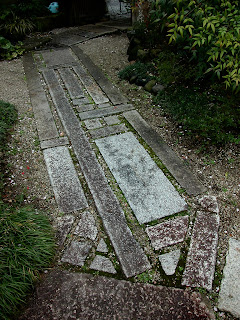羽 風 庵
‘Hakaze-an'
In Japan and China it is common practice to name buildings and gardens. Naming something gives it an extra depth to its character. At this project in the south of England, I was commissioned to create a Tea Pavillion and garden. The clients want a place of quietude and beauty, a meditative loci set in the garden or landscape. All gardens are paradisial settings, where the location is intended to inspire, uplift and act on the viewer in a positive manner.
The inspiration for the original design of the building came about in an unexpected way. I wanted to create a building that was 'light' looking, seeming to float in its space. As I walked down to the area one morning a pigeon took off from the ground. I had my moment of inspiration; the shape of the roof, and the garden would be derived from a bird's wing. Later researching in Nelson's 'Japanese-English Character Dictionary', I found what I was looking for, a name.
In Japanese Hakaze-an, is made up of three characters; ha - represents a wing, kaze - breeze, draught or wind, the suffix -an means a hermitage. Hakaze together indicates 'the breeze created by a bird flapping its wings', perhaps in taking off from the ground or a branch. It is a cooling, calming image, it has a sense of lightness and elevation about it. The ideal of a hermitage, indicates a place separate from the trials of the everyday world, a place apart from hustle and bustle. A place to retire to, to simply be. Thus Hakaze-an, can also be called the 'Hermitage of the Breeze From A Wing', its simpler mouthful in Japanese. Hakaze-an.
 |
The area where the building is to be sited is at the bottom of a gentle slope
with a tall backdrop of established trees. |
 |
| The boxes are preparation for the concrete pads to hold the main upright timbers supporting the roof. |
 |
Robert Ketchell, project designer with Andrew Ninnis, master builder,
blessing the building and the site. |
A ceremony was recently held to bless the building, the craftsmen, and the site, in order to attract beneficial energy to the project. Right Mind is an important consideration when evoking beauty, in no matter what you do. Holding a ceremony brings conscious attention to the process of creation. What ever we bring to the project, good or bad, beneficial or a hindrance, will stay within the creation, and become a part of what someone else will take from the experience of the garden and building. So we all need to be aware of bringing the best we can to whatever we do.
In honouring the intention and the process of creation, it is to recognise the potential of space to be sacred. Creating Beauty in whatever form it may manifest, is part of a search for the sound of the voice of the divine in the landscape.
This is a copy of the script for the site blessing ceremony:
Ceremony of Blessing for the Tea Pavillion ‘Hakaze-an'
羽 風 庵
(‘Pavillion of the
Breeze Created By the Wings of a Bird’)
Each corner of the
building is blessed by sprinkling sake, salt and water.
Evoking the Lotus
Sutra:
NAM-MYOHO-RENGE-KYO
NAM-MYOHO-RENGE-KYO
NAM-MYOHO-RENGE-KYO
At the entrance to
the building:
Sake, salt and water
is sprinkled on the ground.
Recite:
May this building,
Hakaze-an, be blessed
By good intention and
the right mind;
Where the hand
follows the heart,
And the heart follows
the hand into calm breath.
May this building,
Hakaze-an, be blessed
By the viewer seeing
both inside and outside as One;
Where the senses
follow the heart
And the heart follows
the senses into the present.
May this building,
Haukaze-an, be blessed
As a place of meeting
of earth and sky;
Where the mind
follows the heart
And the heart follows
the mind into emptiness.
NAM-MYOHO-RENGE-KYO
NAM-MYOHO-RENGE-KYO
NAM-MYOHO-RENGE-KYO
At the main garden
site:
Sake, salt and water
is sprinkled on the ground.
Recite:
For the garden which
is the path and the view,
The means and the way
The outside that
becomes the inside;
May you reveal
yourself through Beauty.
Salt is to feed the
earth
Water is the presence
of the sea
Sake is for the
laughter of the gods;
May you reveal
yourself as sacred space.
NAM-MYOHO-RENGE-KYO
NAM-MYOHO-RENGE-KYO
NAM-MYOHO-RENGE-KYO
 |
| View from the interior space looking out to where the principal garden view will be. The large maple in the centre will remain and the garden design laid out to place it at the centre of the composition. |
 |
| The main frame of the building is of Western Red Cedar grown in the UK. The main sitting space will be open to the elements in order to allow the maximum sensory experience of the surrounding gardens. |
 |
| The wildflower meadow in the middle ground is to be developed as a large pond |
 |
| A preliminary sketch of the pond layout. The shape of the pond is derived from the character for 'heart' (kokoro in Japanese). This style of pond is known as Shinjiike. |
 |
| The entrance to the building is where the yellow step ladders are stood. It will be an open doorway. A path will lead the visitor to this point. The main viewing garden will be on the other end of the building. |
 |
| The roof will be covered in sedum plants and will 'float' over the garden surrounding the building. The garden area has yet to be started. This will feature in successive posts on this blog. Walls are to be created at the front end of the building, the main sitting area will be open. The main posts will act as frames to capture garden views. |
The creation of the building and garden will feature in a series of blogs. Sign up for e-mail delivery to follow the progress of this fascinating project. The building is the kernel of the whole space, with a garden to wrap around it. The way through the garden to the building is a journey made to prepare the visitor to enter the building itself. Once in the building, the gardens as seen from within will calm the mind; as the inside becomes the outside and the outside becomes the inside.
Project Manager/Designer: Robert Ketchell
Architectural Consultant: Andrew Broughton-Tompkins
Master Builder: Andrew Ninnis
To follow this blog:
the 'Follow by E-mail' facility is now operating.
Don't miss a beat and sign in.



















































